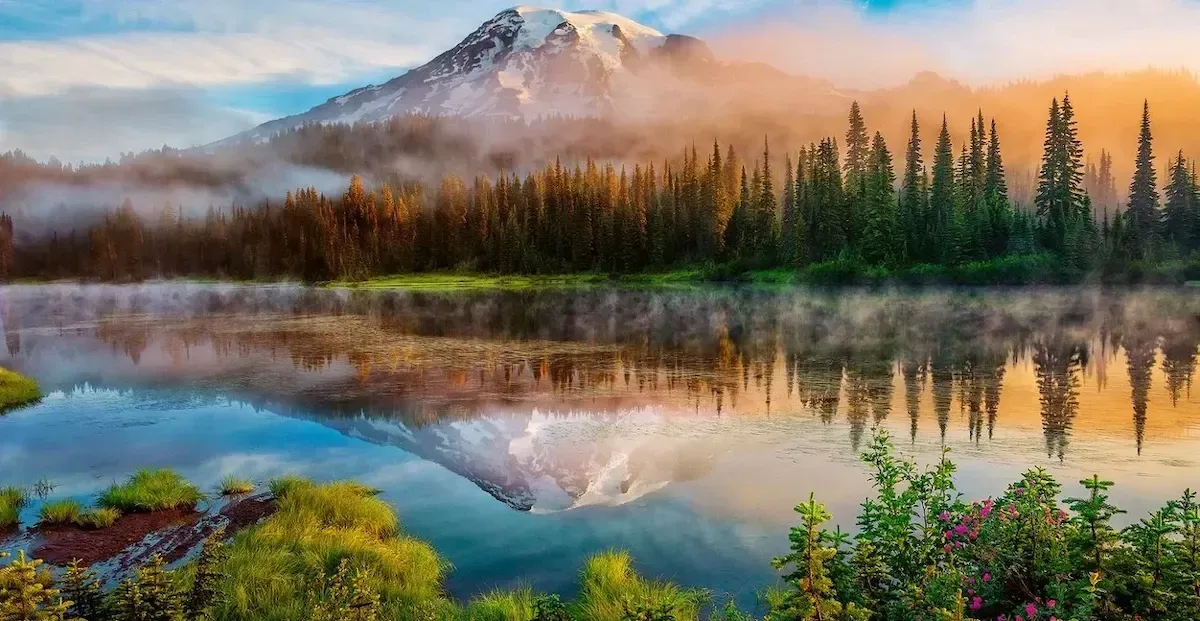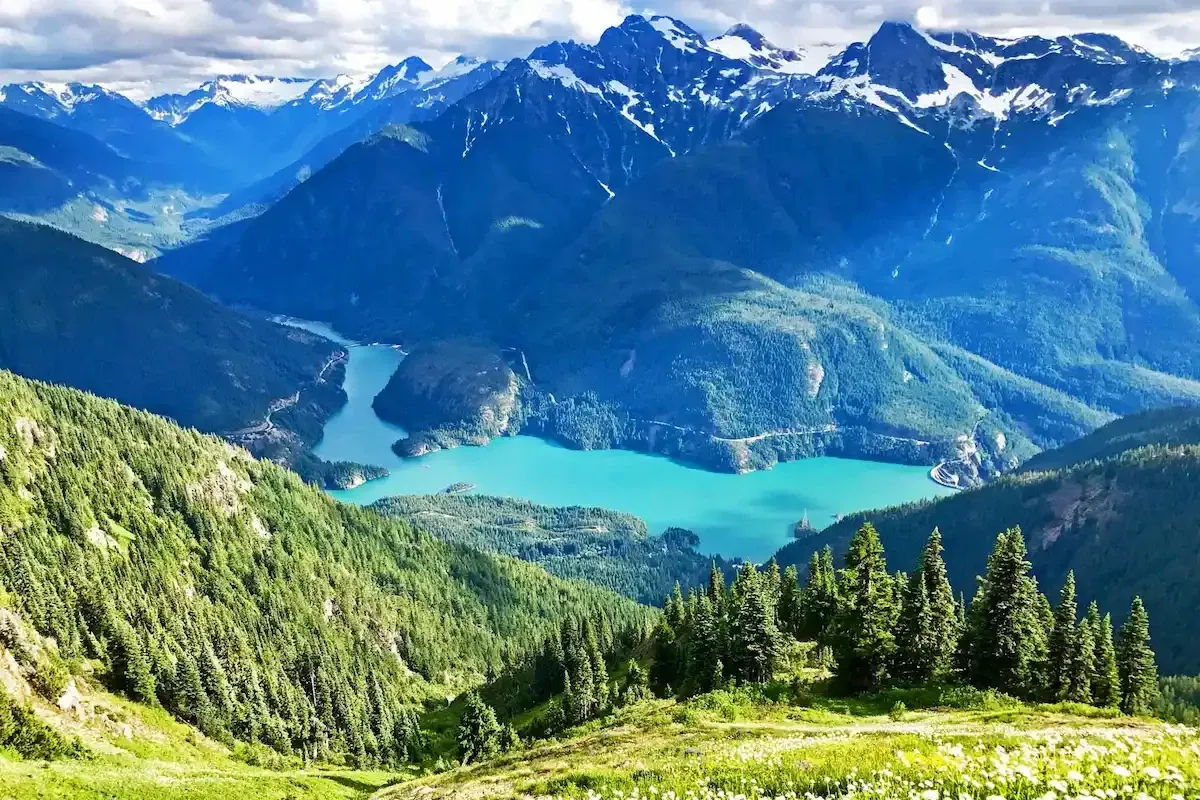The Cascade Range, stretching like a natural wall between the sky and land of North America, is not only a geological wonder with towering volcanic peaks and diverse ecosystems, but also a true paradise for passionate trekking enthusiasts. If you are seeking a journey to explore unspoiled, majestic beauty and challenge yourself amidst vast nature, the Cascade Range is an unmissable destination. This article from “Du lịch khắp thế gian” (Travel the World) will be your detailed guide, leading you into the enchanting world of trekking in the Cascade Range, where every step is a new discovery.
Cascade Range – An Ideal Trekking Destination
The Cascade Range, also known simply as the Cascades, is part of the Pacific Ring of Fire, extending from British Columbia (Canada) to Northern California (USA). With countless peaks over 3,000 meters high, primeval old-growth forests, majestic waterfalls, and jade-like blue lakes, the Cascade Range presents a magnificent and diverse natural tapestry. In particular, with a rich system of trekking trails, from easy to difficult, this place attracts millions of visitors each year, eager to conquer and explore.

Why is the Cascade Range a Trekking Paradise?
It’s no coincidence that the Cascade Range is dubbed a “trekking paradise.” It converges the ideal elements to create memorable trekking journeys:
Diverse Terrain and Spectacular Landscapes
The Cascade Range boasts some of the most diverse terrain, from dreamy alpine meadows, lush pine and fir forests, to steep rocky slopes and majestic glaciers. This diversity creates trekking routes that are never boring; each step reveals a new scene, a different experience. You can trek through dense old-growth forests, climb volcanic peaks to admire panoramic views, or walk along the shores of clear blue lakes to enjoy tranquility.
Rich System of Trekking Trails
With thousands of miles of marked and well-maintained trekking trails, the Cascade Range caters to all levels and preferences of hikers. Whether you are a beginner or a seasoned trekker, you can find suitable routes. National parks and national forests within the Cascade Range region all have detailed trail maps and information about difficulty, length, and estimated time for each route.
Untamed and Majestic Natural Beauty
The Cascade Range retains its rare, unspoiled, and majestic beauty. Less impacted by human activity, it offers a sense of closeness to nature, separated from the noise and bustle of urban life. When trekking in the Cascade Range, you will immerse yourself in the serene space of mountains and forests, listen to birdsong, the murmur of streams, and breathe in the fresh air.

Most Famous Trekking Trails in the Cascade Range
The Cascade Range has countless stunning trekking trails, but here are some of the most famous and beloved:
Cascade Pass Trail
Located in North Cascades National Park, the Cascade Pass Trail is one of the most accessible and beautiful trekking trails in the Cascade Range. Approximately 6 miles (9.6 km) round trip, this trail leads you to Cascade Pass, a magnificent viewpoint with 360-degree views of the majestic North Cascades. The path is quite gentle, suitable for families and beginner trekkers.
Wonderland Trail
The Wonderland Trail is a legendary long-distance trekking trail, encircling Mount Rainier in Rainier National Park. With a total length of 93 miles (150 km), this trail is often divided into smaller sections, each offering different experiences. Trekking on the Wonderland Trail, you will admire the diverse beauty of Mount Rainier, from old-growth forests, waterfalls, alpine meadows to glaciers and lakes.
Skyline Trail
The Skyline Trail is another famous trekking trail in Rainier National Park, starting from Paradise, an area renowned for its summer wildflowers. This trail is approximately 5.5 miles (8.8 km) round trip, leading you through vibrant alpine meadows to Glacier Vista, where you can get a close-up view of the Nisqually Glacier and the magnificent mountain scenery.
Timberline Trail
The Timberline Trail is a stunning long-distance trekking trail, encircling Mount Hood in Mount Hood National Forest. Approximately 41.5 miles (66.8 km) long, this trail takes you through diverse terrains, from dense forests, waterfalls, to rocky mountains and glaciers. The Timberline Trail is famous for its majestic views of Mount Hood and vibrant wildflower meadows in the summer.
Pacific Crest Trail (PCT)
The Pacific Crest Trail (PCT) is one of the longest and most famous trekking trails in the world, stretching from the Mexican border to the Canadian border, passing through the Cascade Range. Many sections of the PCT traverse the Cascade Range, offering incredible trekking experiences. You can choose to trek a short section of the PCT to experience the grandeur of the Cascade Range.

Trekking Experience in the Cascade Range
To have a safe and memorable trekking trip in the Cascade Range, you need to prepare thoroughly in terms of fitness, skills, equipment, and knowledge of the area.
Best Time to Trek
The ideal time for trekking in the Cascade Range is summer (from July to September) and early autumn (September, October). In summer, the weather is warm, dry, and trails are open after the winter snowmelt. Autumn brings cool, pleasant air and stunning golden foliage. However, you should note that mountain weather can be unpredictable, especially at higher altitudes.
Fitness and Skill Preparation
Trekking requires good physical fitness and hiking skills. Before starting your journey, you should exercise regularly, especially exercises that enhance endurance and leg strength. If you are new to trekking, choose short and easy trails first, then gradually increase the difficulty and length. Learn about the map, altitude, and terrain of your chosen route to prepare mentally and with appropriate skills.
Essential Equipment
Trekking equipment plays a crucial role in ensuring safety and comfort for your trip. Here is a list of essential equipment:
- Trekking shoes: Choose specialized shoes with good grip, waterproof and breathable.
- Trekking backpack: Choose a backpack with a size suitable for the length of your trip and the amount of gear you carry.
- Trekking clothing: Wear layers of clothing, made of quick-drying, breathable, and warm-keeping materials.
- Tent, sleeping bag, sleeping pad (for multi-day treks): Choose a tent and sleeping bag suitable for weather conditions and temperature.
- Food and water: Bring enough drinking water and energy-rich snacks for the entire journey.
- Map, compass, or GPS: For navigation and tracking your route.
- First aid kit: To treat minor injuries and common health issues.
- Flashlight or headlamp: For moving in the dark or when it gets dark.
- Sunscreen, sunglasses, hat: To protect your skin and eyes from the sun.
- Multi-tool knife, lighter, paracord: Useful items in many situations.
Trekking Safety
Safety is always the top priority in any trekking trip. Always pay attention to the following factors to ensure safety for yourself and your companions:
- Monitor weather: Check the weather forecast before and throughout your trip.
- Go in groups: Trekking in groups is safer, especially on difficult trails or in remote areas.
- Inform others of your itinerary: Let family or friends know your itinerary and expected return time.
- Follow signs and instructions: Stay on marked trails and follow signs and instructions from national parks or national forests.
- Be careful with wildlife: Learn about the wildlife in the area and how to behave when encountering them.
- Avoid going alone in dangerous areas: Do not venture into areas with dangerous terrain or bad weather alone.
- Carry communication devices: Mobile phones or satellite communication devices can be useful in emergencies.

Cascade Range Trekking Tips for Beginners
If you are new to trekking in the Cascade Range, refer to these tips for a smooth start:
- Choose easy trails: Start with short, easy trails with moderate slopes.
- Go with experienced trekkers: If possible, go with people who have experience trekking in the Cascade Range.
- Learn about the trail thoroughly: Study maps, read reviews, and find information about your chosen trail.
- Prepare your fitness in advance: Exercise before your trip to get your body used to the intensity of activity.
- Pack just enough gear: Do not carry too much gear to avoid fatigue and heaviness.
- Drink enough water: Drink water regularly to avoid dehydration, especially when trekking in hot weather.
- Eat adequately: Provide enough energy for your body by eating adequately and bringing snacks.
- Walk slowly and rest properly: Do not try to go too fast, walk slowly and rest when needed.
- Listen to your body: Pay attention to your body’s signals and stop to rest or turn back if you feel too tired or unwell.
Important Notes When Trekking the Cascade Range
- Permits and regulations: Some areas in the Cascade Range require trekking permits, especially for multi-day trails or overnight camping. Research the regulations and necessary permits before going.
- Respect nature: The Cascade Range is a precious natural area, respect the environment by not littering, not making loud noises, and not damaging plants or animals.
- Comply with national park and national forest regulations: National parks and national forests have their own regulations regarding trekking, camping, campfires, etc. Learn and comply with these regulations.
- Prepare good mental and physical health: Trekking can be a physical and mental challenge. Prepare yourself mentally to face difficulties and challenges, and always maintain a positive attitude.
Conclusion
Trekking in the Cascade Range is a wonderful experience, offering the opportunity to explore majestic natural beauty, improve your health, and challenge yourself. With thorough preparation and an adventurous spirit, you will have a memorable and inspiring trekking journey in the “trekking paradise” of the Cascade Range. Plan your trip today and discover the wonders this mountain range has to offer!